
This article was updated on October 5th, 2023

A skin tag is a benign growth that develops on the surface of your dog’s skin. They vary in appearance with a range of different sizes, shapes and colors (From pink to black). In this article, we will review over 10 pictures of skin tags, as well as pictures of other types of dog lumps that can be easily mistaken for skin tags.
What do skin tags look like? [with pictures]
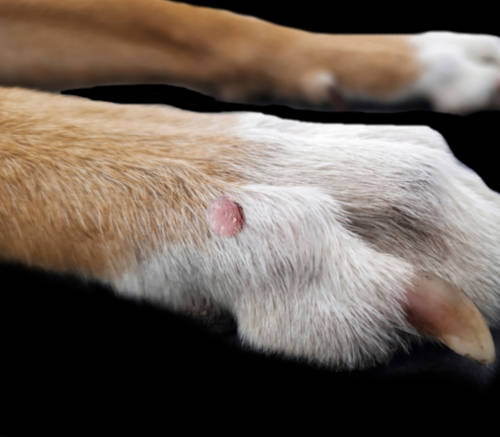
Many skin tags are pedunculated – this means that they are attached to the skin via a narrow stalk leaving them dangling in space.
Pictures of skin tags on dogs:
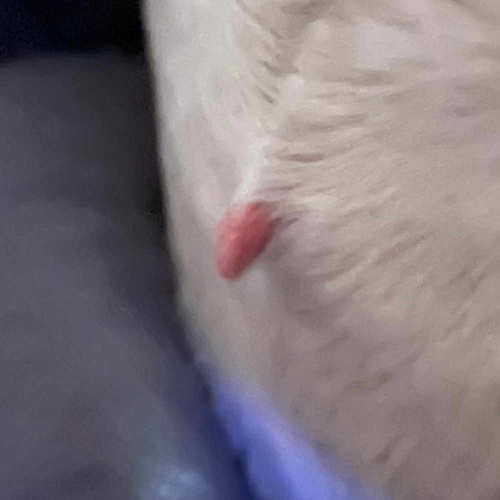
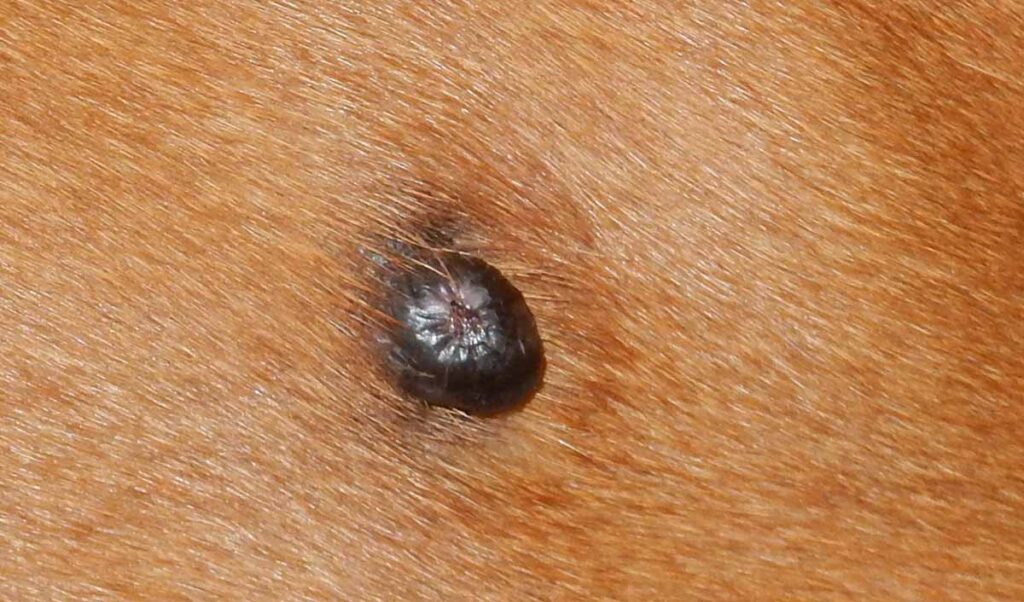
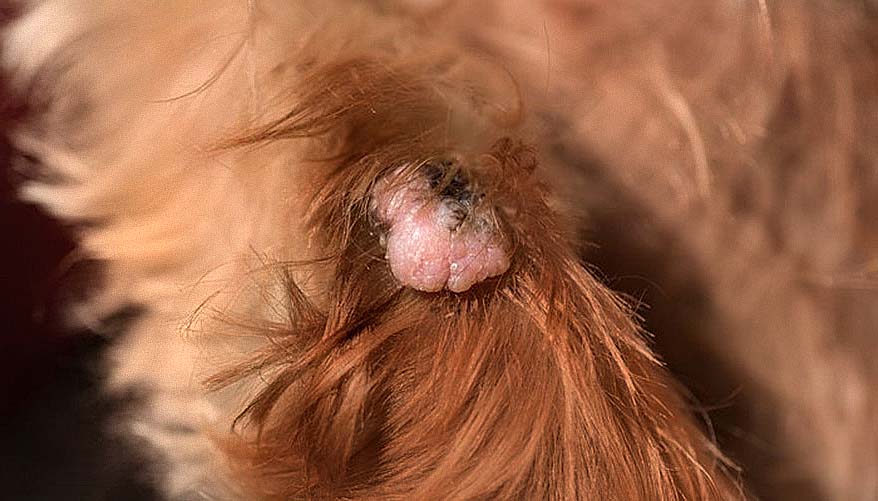
Skin tags are more common in older animals and large breed dogs, although any dog can develop a skin tag. Skin tags most commonly appear on the face, chest, armpits, and legs of your dog, but they can grow anywhere on your dog. See this picture of a skin tag on a dog’s lips.
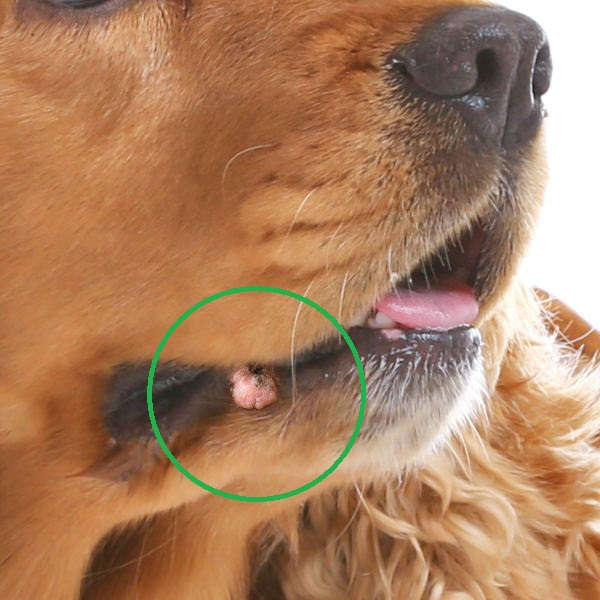
Sometimes also referred to as an acrochordon, fibroepithelial polyp, or hamartoma (amongst other names), a skin tag is formed from an overgrowth of collagen and small blood vessels and is essentially a ball of extra skin attached to the surface of your dog.
Larger skin tags
Most of the pictures reviewed so far are small to medium size skin tags. Skin tags can be small or large. This dog pictured below has had a large skin tag on his leg for over a year. The lump is large, hairless, bruised and not well attached to the skin. However, it is benign and does not necessarily need to be removed unless it bothers the dog or starts to bleed or get infected:
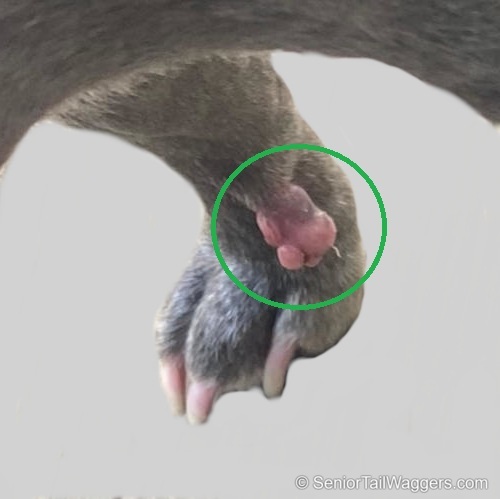
There are 2 different types of skin tags on dogs
- Fibroadnexal hamartoma
These are the most common type of skin tags seen in dogs and are composed of a mixture of collagen and blood vessels. They usually form in areas of high friction and are hairless. They are generally not serious unless they are constantly rubbing on the ground and causing irritation, in which case they can be removed.
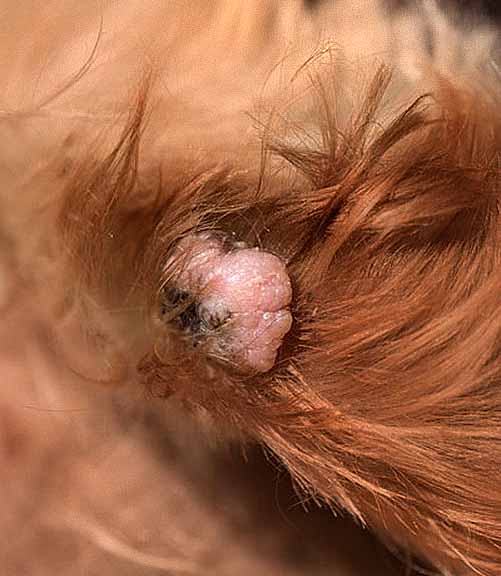
- Follicular Hamartoma
These are a less common type of skin tag in dogs. They appear as a flat mass covered in hair. These are also benign and generally nothing to worry about as long as they aren’t causing irritation by rubbing or catching on objects. They can be removed surgically if necessary.
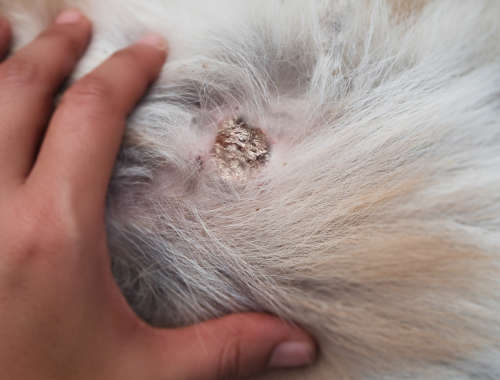
Picture of an irritated or bleeding skin tag
Skin tags may bleed if your dog keeps catching them on objects around the house. On the picture below, you can see a red and inflamed skin tag, with minor bleeding on the surface.
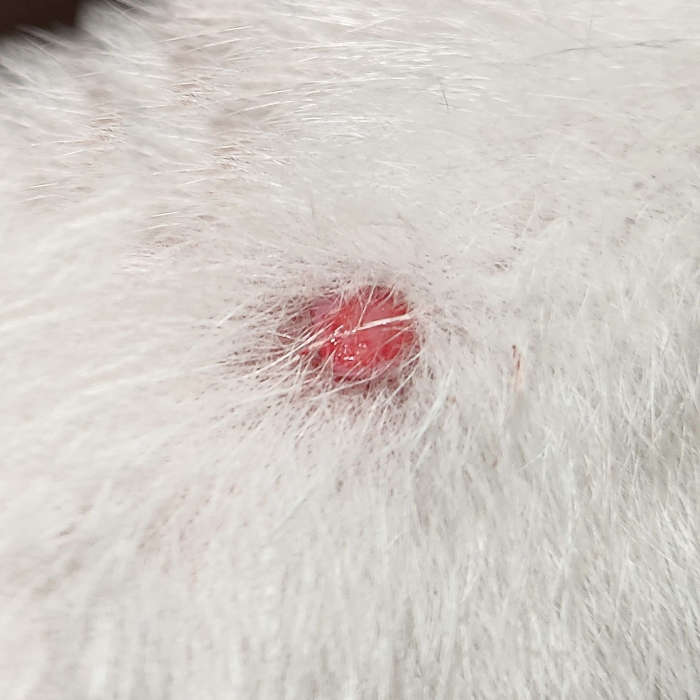
This can become irritating for both you and your dog, and so is a valid reason to have an otherwise benign skin tag removed. However, if a skin tag spontaneously bleeds or appears ulcerated, without any apparent trauma, then it may be a sign of malignancy; cancerous masses often ooze blood, so get any bleeding lumps checked out by your vet.
Can skin tags be cancerous?
Skin tags are benign and therefore not cancerous by definition. As long as a skin tag isn’t changing in shape, size, or color, or is not bothering your dog, then it is generally nothing to worry about.
Important: keep in mind that it is usually not possible to confirm a lump diagnosis just by looking it. A lump that looks like a skin tag could turn out to be a cancerous tumor. Let’s take a look at a few examples.
Cancerous tumors that may look like skin tags
It’s always a good idea to have any suspicious lumps tested by your vet, especially if they are changing in appearance. Below are pictures of tumors that may look like skin tags, but are cancerous:
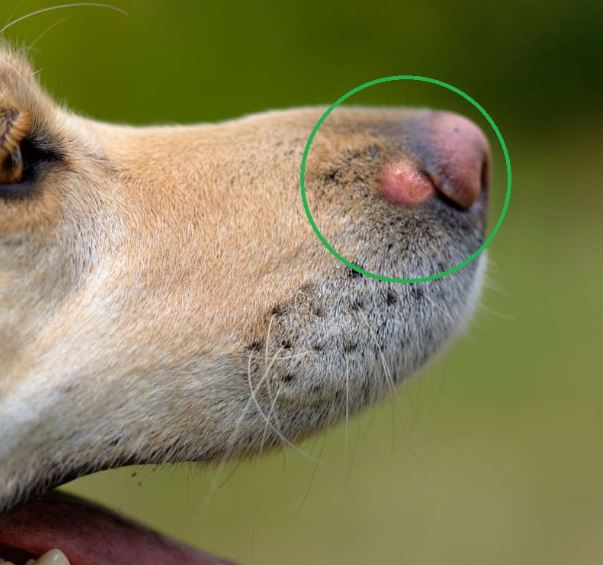
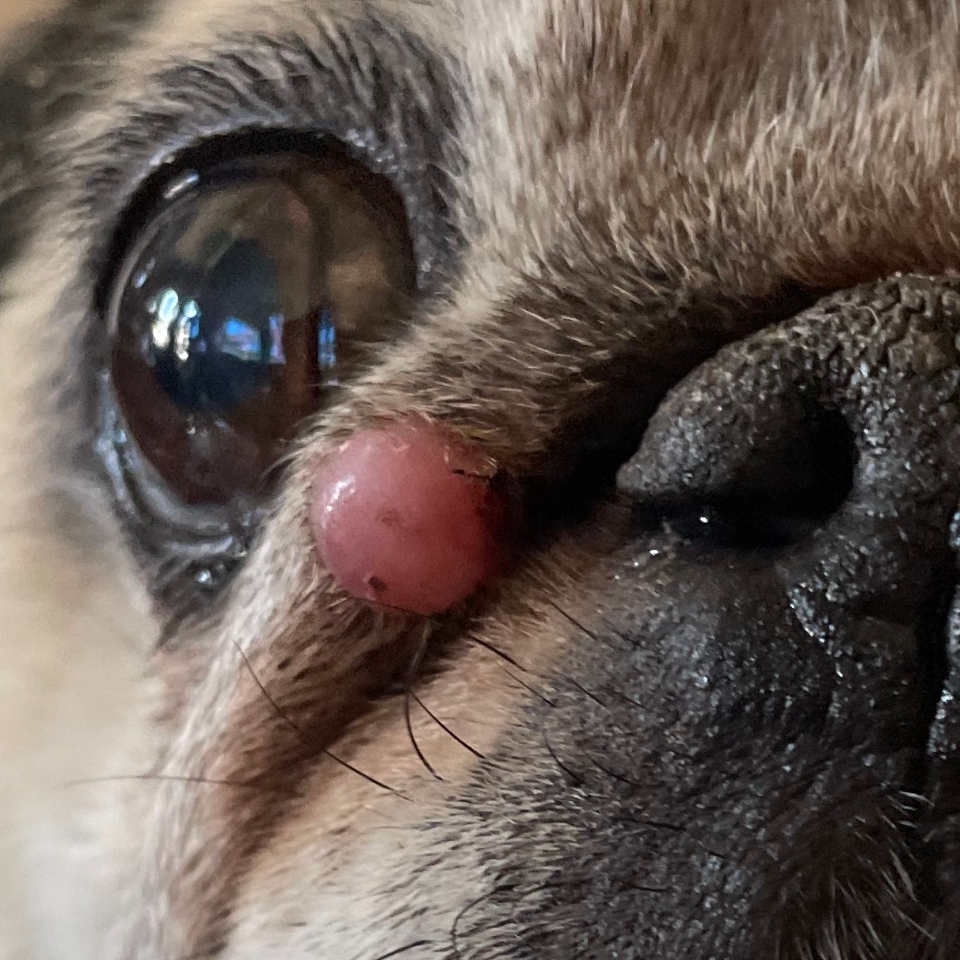
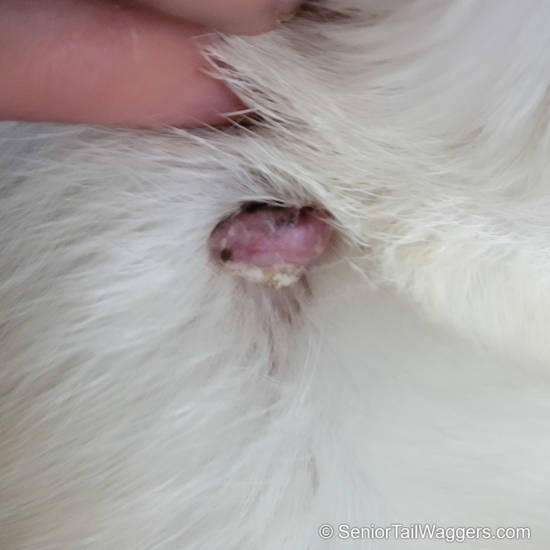
If skin tags are not cancerous, is there any reason to worry about them?
While skin tags are non-cancerous masses that generally don’t cause any harm to your dog, this doesn’t mean that they should be completely ignored.
Skin tags often develop on areas of your dog’s skin where there is high friction, such as areas that are in contact with the ground or their collar. Over time, constant rubbing of these skin tags will lead to irritation and may be painful for your dog.
Damage to the surface of a skin tag also leaves it prone to infection. If your dog keeps rubbing or knocking a skin tag, then it might need to be surgically removed by your veterinarian.
It’s very important to monitor skin tags and detect any change in size or color
Even benign skin masses have the potential to become malignant and so any sudden change in appearance should be examined by your veterinarian; so should ulcerated or bleeding masses.
Other signs of malignancy include:
- Your dog seems more irritated by their skin tag than before.
- Your dog’s skin tags appear to be painful when touched.
In the vast majority of cases, skin tags will remain the same for your dog’s lifespan and usually aren’t anything to worry about, but if you have any concerns then have your veterinarian test your dog’s lumps.
Lumps That Look Like Skin Tags but Are NOT
There are many other things that can masquerade as a skin tag in dogs. It is therefore important to be able to recognize what is and what isn’t a skin tag, as the treatment may be very different.
1.Warts may look like skin tags
Dog warts, like skin tags, are benign lumps on your dog’s skin. They are caused by an infection with a virus known as canine papillomavirus, and while they generally won’t cause any harm to your dog, they can be easily mistaken for cancerous tumors. Therefore, it’s always important to have them checked by your vet. Read our article: Is it a Wart or a Skin Tag?
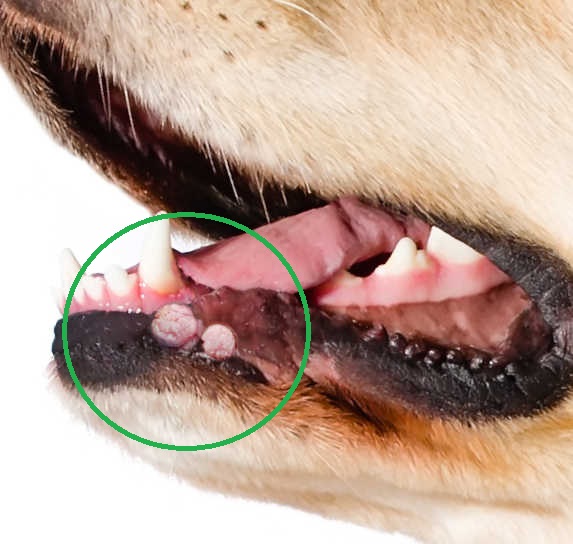
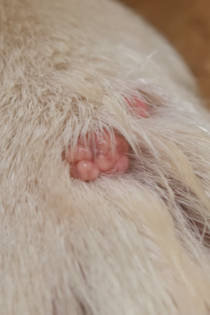
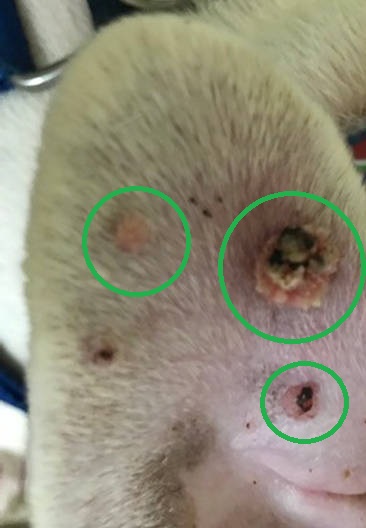
2.Sebaceous adenomas
These tumors typically appear as small, raised, and well-defined growths on the skin. They can vary in size and may be solitary or multiple. Sebaceous adenomas often have a wart-like or cauliflower-like appearance consisting of many bumps or lobes. Colors can range anywhere from pink to brown.
Read our article about Sebaceous Adenomas.
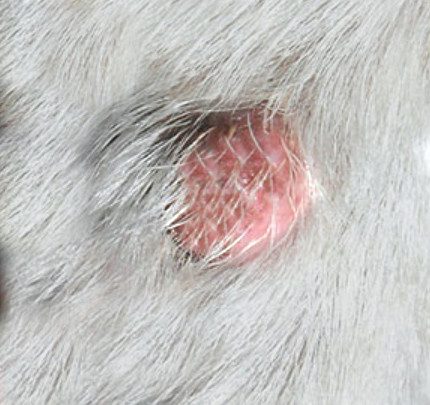
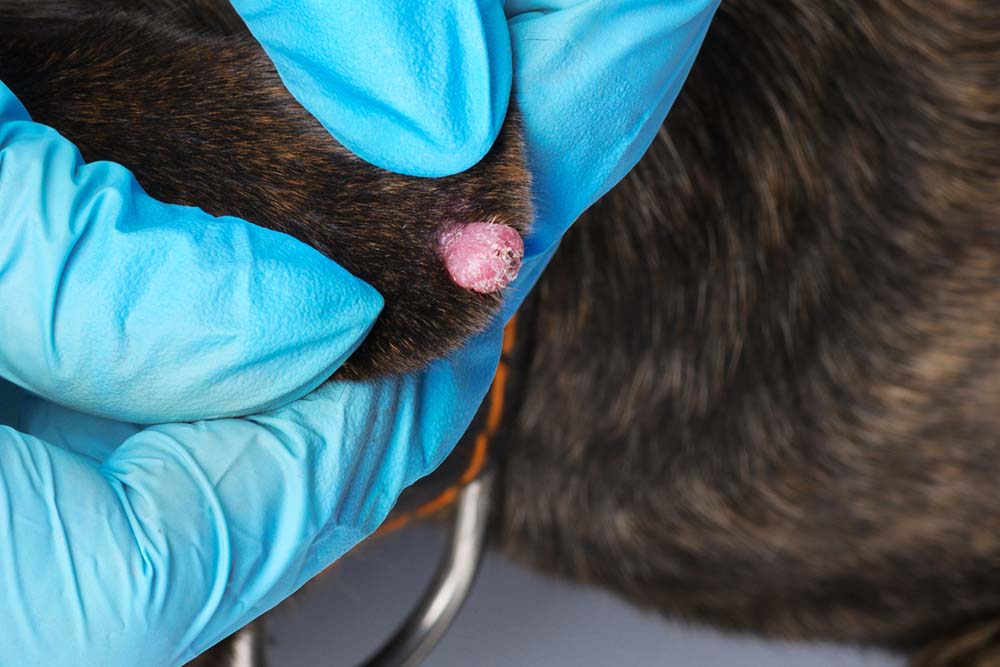
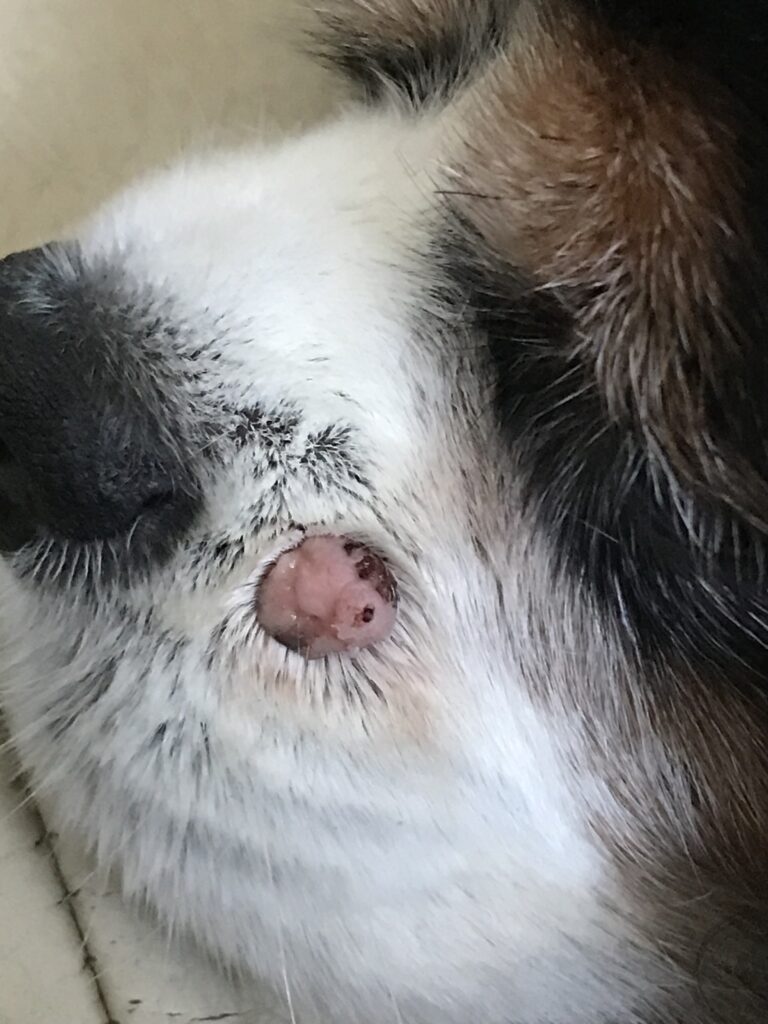
3. Ticks
A tick is a parasite that buries its head into your dog’s skin in order to feed on blood, gross! As the tick feeds, its body swells up to the point where, to the untrained eye, it can look suspiciously similar to a skin tag. However, when you look closely at a tick you may notice small legs coming from the body.
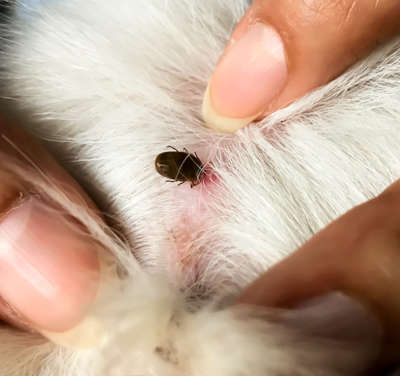
4. Nipples
While the difference may be obvious to many, skin tags can be easily mistaken for your dog’s nipples. Both male and female dogs have nipples. Females’ nipples will often enlarge when they are in heat and this is often the time that owners will mistake a nipple for a skin tag.

Think about where the ‘skin tags’ are. Are they symmetrical on each side of your dog’s chest? If so, it’s likely a nipple, and so it certainly shouldn’t be removed!
Skin Tags Q&A with Dr. Alex Crow, Veterinarian
Can skin tags be black?
Skin naturally contains a pigment known as melanin, which gives skin its darker color. Since skin tags are composed of skin cells, it’s possible that skin tags can appear darker or even black. While this generally isn’t of too much concern, if an old skin tag has recently turned black, it might be a sign of something more sinister.

A type of cancerous tumor known as a malignant melanoma can easily be mistaken for a black skin tag, therefore it’s better to be safe and have any new dark lumps tested by your vet.
What causes skin tags in dogs?
While the exact causes of skin tags are not completely understood, there are a few factors that may be involved. These include previous trauma to that area of skin, genetic factors, parasitic infection, poor skin hygiene, and skin infections. However, these causes are up for debate, and so the development of skin tags is out of our control.
What about skin tags on my dog’s eyes?
One location where skin tags can develop is on or around the eyelids. While these masses are benign, they can impede your dog’s vision or even rub on the surface of the eye resulting in eye ulcers and conjunctivitis. If your dog has a lump near their eye that is bothering them, then it might be a good idea to have it surgically removed by your vet.
How do you remove a skin tag from a dog? (FAQ)
If you think that a skin tag needs to be removed because it is bothering your dog or repeatedly getting caught on objects, then there are right and wrong ways to do so.
Q: How do you get rid of skin tags on dogs naturally?
A: Some skin tags may shrink over time, but very rarely will they disappear completely. So, there is no ‘natural’ way to remove a skin tag.
Q: Can I remove my dog’s skin tag myself?
A: It is not a good idea for an owner to try and remove a skin tag themselves at home. Not only will it be painful for your dog, but it will likely create an open wound that is susceptible to infection. Skin tags should only be removed surgically under sedation or a general anesthetic. This ensures that the skin tag won’t come back and allows the skin to heal properly.
Q: Can I cut off a skin tag with nail clippers?
A: Absolutely not. For the same reasons mentioned above, this will create an open wound for infection and be extremely painful for your dog. It is also highly likely that the skin tag will grow back.
Q: Do skin tags grow back once removed?
A: If removed surgically by your veterinarian, it is unlikely that a skin tag will grow back as the surgery aims to remove all the cells that make up the lump. If a skin tag is removed at home, however, the likelihood of recurrence is higher as it is unlikely that all of the mass is removed successfully.
Q: How will my vet remove a skin tag?
A: Your vet will remove the skin tag in its entirety by cutting it off with a scalpel blade. The remaining incision will then be carefully stitched back together. It is also possible to cryogenically freeze a skin tag until it drops off.
Other types of lumps and bumps
If you are not sure if your dog’s lump or bump is a skin tag, wart, tumor, cyst, or something else, view our picture gallery or read our article: is it a wart or a skin tag? Remember that it can be challenging to determine the true nature of a bump or lump just by looking at it. A veterinary examination is required in most cases.
Read More About Dog’s Lumps and Bumps
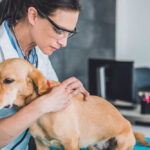 11 Types of HARD Lumps on Dogs [With Pictures] - Hard lumps can be a wide range of things, some of which are worrying and sinister and others that are… [...]
11 Types of HARD Lumps on Dogs [With Pictures] - Hard lumps can be a wide range of things, some of which are worrying and sinister and others that are… [...] 6 Types of Black Lumps on Dogs [With Pictures] - It can be concerning to see a new black lump on your dog, particularly because black growths may mean cancer… [...]
6 Types of Black Lumps on Dogs [With Pictures] - It can be concerning to see a new black lump on your dog, particularly because black growths may mean cancer… [...] White Bumps on Dogs: 7 Vet-Explained Causes with Pictures - White lumps and bumps might seem unusual. However, as a veterinarian, I have seen them more often than you might… [...]
White Bumps on Dogs: 7 Vet-Explained Causes with Pictures - White lumps and bumps might seem unusual. However, as a veterinarian, I have seen them more often than you might… [...] 5 Causes of Bumps on a Dog’s Chin [Pics & Vet Advice] - It’s always concerning to see bumps developing on your dog’s chin: they’re unsightly and often cause your dog irritation and… [...]
5 Causes of Bumps on a Dog’s Chin [Pics & Vet Advice] - It’s always concerning to see bumps developing on your dog’s chin: they’re unsightly and often cause your dog irritation and… [...] Chest or Rib Cage Lumps In Dogs [Vet Advice] - Lumps and bumps on dogs' chests and rib cages are a common finding in our vet clinic, especially in older… [...]
Chest or Rib Cage Lumps In Dogs [Vet Advice] - Lumps and bumps on dogs' chests and rib cages are a common finding in our vet clinic, especially in older… [...]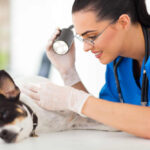 Mast Cell Tumors vs Histiocytomas in Dogs [10 pictures] - According to research, histiocytomas make up 15.9% of tumors found in dogs, while mast cell tumors make up 17.8%. In… [...]
Mast Cell Tumors vs Histiocytomas in Dogs [10 pictures] - According to research, histiocytomas make up 15.9% of tumors found in dogs, while mast cell tumors make up 17.8%. In… [...]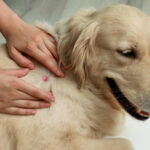 Red Alert: 9 Types of Red Lumps on Dogs [With Pictures] - Seeing a new red lump or bump on your dog can be scary. But don't jump to conclusions just yet.… [...]
Red Alert: 9 Types of Red Lumps on Dogs [With Pictures] - Seeing a new red lump or bump on your dog can be scary. But don't jump to conclusions just yet.… [...] Mast Cell Tumors In Dogs: A Veterinarian’s Guide for Owners - Mast cell tumors are one of the most common forms of cancer in dogs. They account for almost 20-25% of… [...]
Mast Cell Tumors In Dogs: A Veterinarian’s Guide for Owners - Mast cell tumors are one of the most common forms of cancer in dogs. They account for almost 20-25% of… [...] Is It a Dog Wart or a Skin Tag? How to Tell the Difference [6 Pictures to Compare] - Warts and skin tags are common occurrences on our pup’s skin. At first glance, they may appear the same, but… [...]
Is It a Dog Wart or a Skin Tag? How to Tell the Difference [6 Pictures to Compare] - Warts and skin tags are common occurrences on our pup’s skin. At first glance, they may appear the same, but… [...] Pictures of Dog Skin Lesions or Lumps Due to Cancer - As a veterinarian, I often come across dog parents who are concerned about their pet's skin lesions or lumps and… [...]
Pictures of Dog Skin Lesions or Lumps Due to Cancer - As a veterinarian, I often come across dog parents who are concerned about their pet's skin lesions or lumps and… [...]Disclaimer: This website's content is not a substitute for veterinary care. Always consult with your veterinarian for healthcare decisions. Read More.

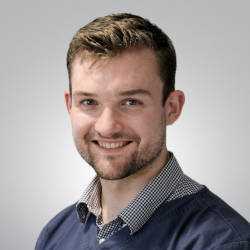

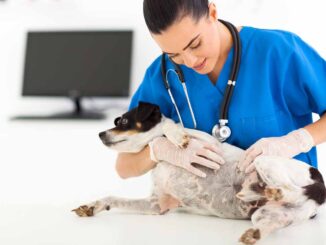

A skin tag has developed near the left leg, on the loose skin and he is licking it often.